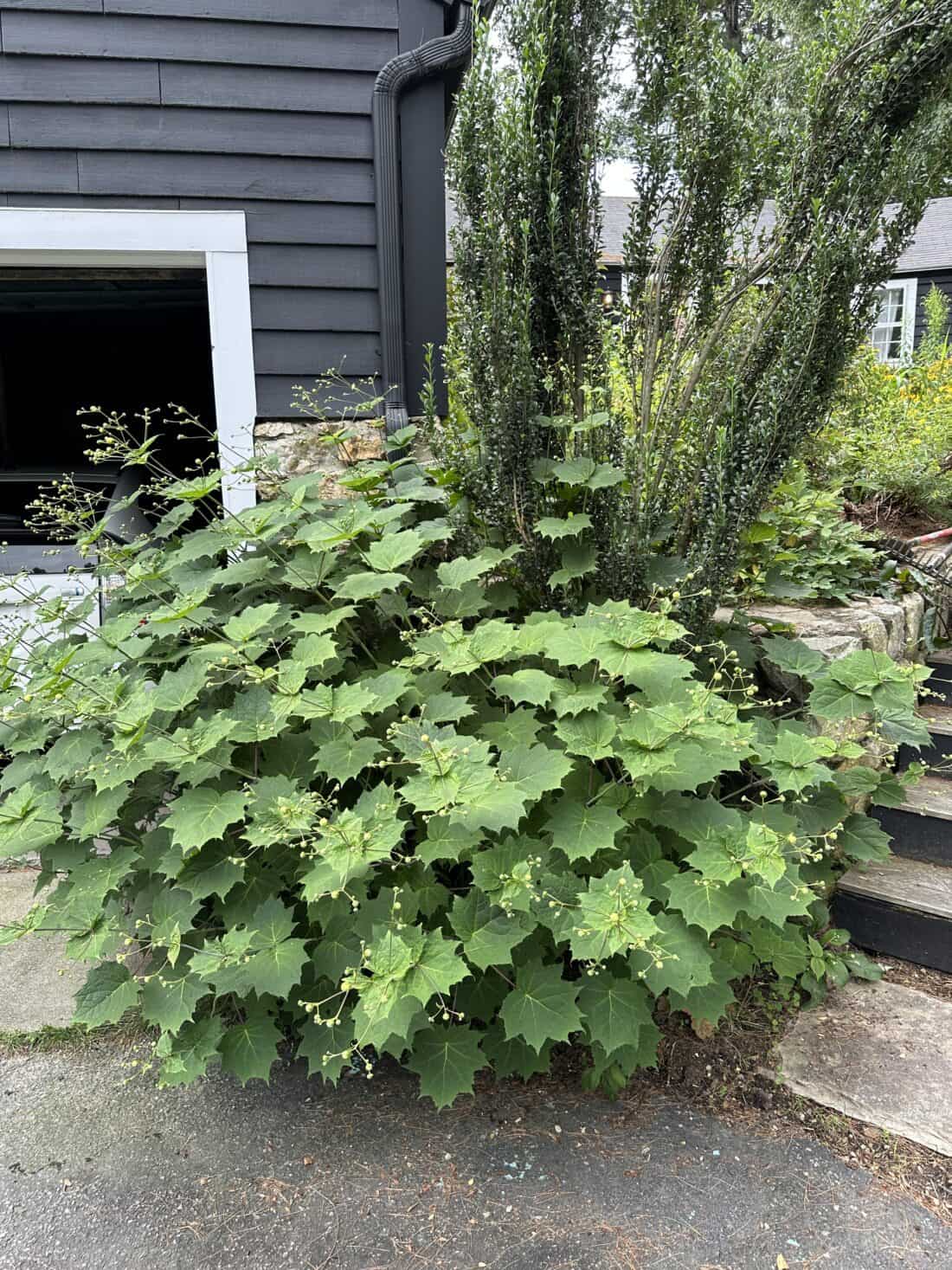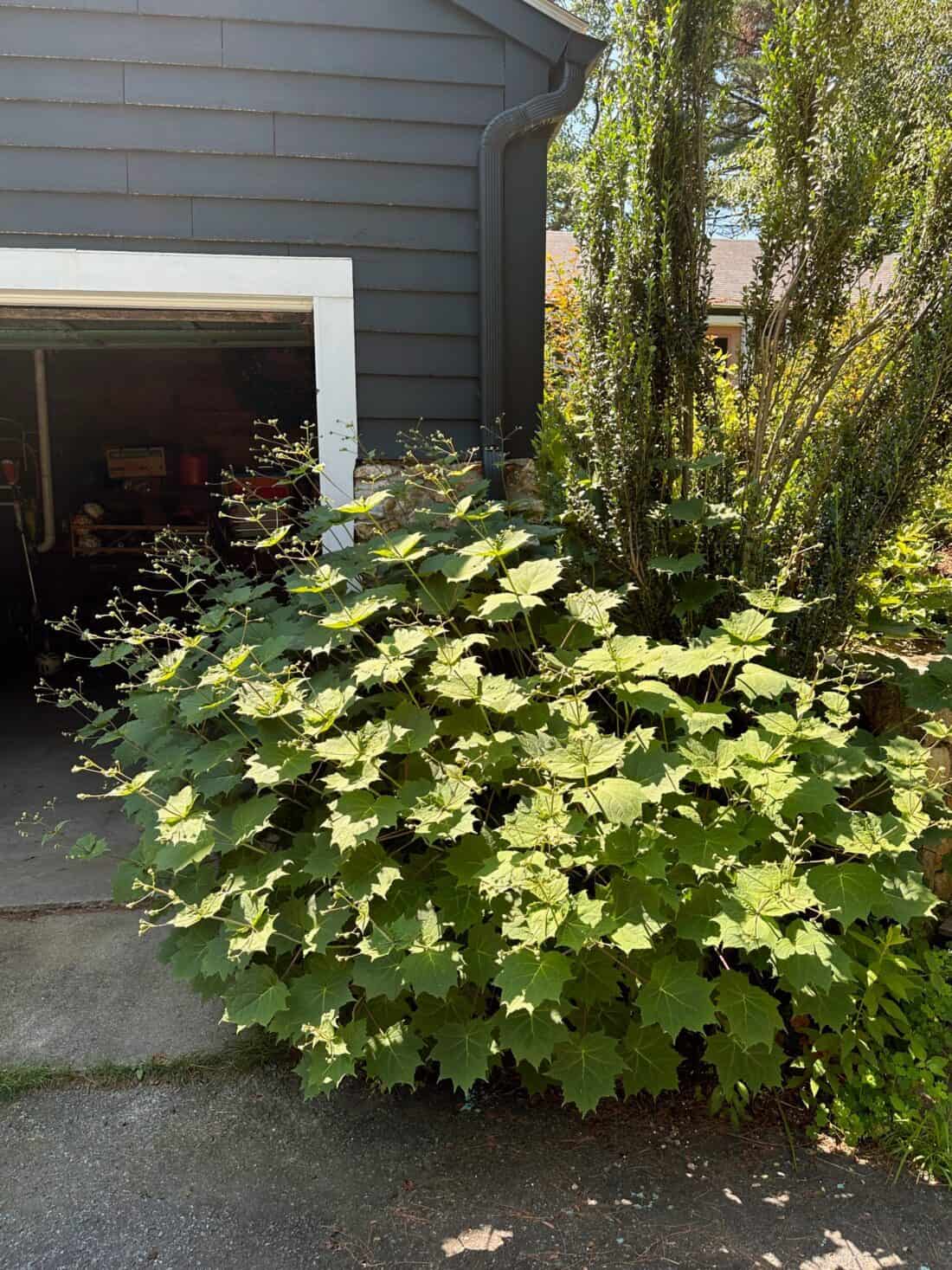I’ve never forgotten my first Kirengeshoma palmata or Yellow Wax bells sighting in an actual garden.
It was back when I was a garden design student making regular trips to Kew Gardens near London to learn about garden plants.

That day, I rounded a corner in a shady woodland garden area and was utterly confronted with the most luscious plant I’d ever seen. At first, it seemed like it must be a shrub given its size (3-4 feet tall) and shape (upright stems create an upright mound with palmate maple-like leaves that definitely make it look like it belongs in the hydrangea family). But I later learned it is actually an herbaceous perennial.
The yellow waxbells’ pretty green leaves and fresh-colored foliage first jumped out at me. Tucked between some trees in a wooded area, and compared to the surrounding foliage plants, it was the lushest, most vivid green thing I had ever seen.
It also happened to be in full bloom (late summer to early autumn), which meant it was covered with the most captivating yellow flowers. The common name – yellow wax bells, refers to the flowers – they are waxy, and they don’t ever actually fully open. The flower buds look like perfectly shaped balls of butter dangling off the plant, and as the waxy yellow flowers open, well, they still look like delicious pats of butter – just bigger and more pendulous. In full bloom, bell-shaped butter flowers cover the plant and are so elegant.
In my love affair with this plant, I have put it in every garden I can, and It is starting to become a bit of a Greayer Design Associates signature plant. I’m happy for it to be something I can uniquely make work – but I honestly don’t know why it isn’t more commonly used.
Where to Plant Kirengeshoma Palmata?
Over the years, I’ve shared and divided k. palmata repeatedly, moving it around, trying it out in many different places. And there are certainly some places that are better than others.

What are the best growing conditions for Yellow Wax Bells?
The plant wants adequate moisture – or at least very consistent moisture. I don’t have a pond or irrigation, but I suspect it would be happy on a dripline or near water. In my garden, it is planted below the rain downspout off the roof – the most consistently wet place. In other areas, I’ve ensured it’s in wetter than average places – but it is clearly most happy below the downspout. My biggest and best plant thrives in about 4 square feet of soil that it shares with daffodils, an ilex sky pencil, and a toad lily. All the other splits are planted in slightly drier spots – and all are less tall, less floriferous, less lush – they are nonetheless seemingly happy plants until you compare it to the one by the downspout. Then you can’t help but wonder if they are all a little envious.
This is not a full-sun plant – it prefers at least partial shade. My best plant is on the north side of my house – (which is part shade and it only gets a couple hours of afternoon sun).
My best plant grows adjacent to the asphalt driveway in well-drained soil with a coarse texture. It seems to like the rocky, less-than-humusy soil. It is native to cool mountainous regions of eastern Asia in Japan, Korea, and China. I hardly ever think of mountains as places where you find deep, fertile soil, so this preference for the crumbly driveway dirt seems to check out.
No one bothers it – it is deer resistant, and I have never had a serious insect issue (TBH – I don’t think I’ve ever seen a single leaf damaged). It is also completely tolerant of the car brushing past it and jostling all its stems at least a couple of times a day.
What Companion Plants Go with Kirengeshoma Palmata?

I have planted mine with toad lilies – which is a good choice because they are both damp, shade-loving perennials – except that the yellow wax bells often overgrow the lilies until I can’t see them. Both plants seem happy, but as a gardener who wants to enjoy all the plants, I think I need to make a change.
Elsewhere, I have them planted with Butterbur (Petasites gigantea), which has large leaves that offer a nice textural contrast, and Cimicifuga (Actaea) racemosa Brunette (which leaves are similar in color to the elegant stems that hold the waxy flowers. Large hostas would also be a good alternative – so would lush tall ferns. All of these are great textural garden plants that grow well in shade gardens.
The pale yellow flowers are a real focal point when they are in full bloom. The whole plant, with its purplish stems, pendulous flowers, and first-rate foliage, is such an eyecatcher you almost don’t need to pair it with much else.
In the picture above, I’ve planted an Ilex Sky pencil adjacent to the kirengeshoma – but the plant is so big that it looks like I have planted it all around the sky pencil.

Other Shade Garden Plant Posts:
Definately my fav under appreciated plant is ceratostigma plumbaginoides or “Blue Leadwort”. Noboby seems to have heard of this plant when I want to buy it. I have put it into 3 gardens that I have had over the years and have always loved it. It is a great low edger or groundcover, mine get about 1′ high and 2-3′ wide. It grows by underground stolons, but it is not invasive. It has the most amazing blue flowers starting in late August and while it is flowering in Sept the leaves become scarlet. I plant it over my early small bulbs as it is late to come up, but then it covers the ratty foliage. It is hardy zones 5-9. It is lovely to find a late flowering plant that is not yellow or orange if you have a colour themed garden. By the way, I love your blog!
a beauty- how does the foliage hold up? though?
does it get raggedy like rogersia? or does it require constant moisture?
Re: kilbournegrove- Plumbago- Ceratostigma plumbaginoides- isnt that leadwort? I find it not so hardy in zone 5 which most of central Ma is- but up around boston would work…a great groundcover- I have used it in South Carolina and it was beautiful for a very long season in the shade.
A favorite- so hard to stay.. so many wonderful creatures in our plant world!
L.
foliage is great….the main reason for the plant. And no one bothers it either….and in my garden, the woodchucks, deer, chippies, slugs, bunnies and moles are winning the battle…but this is strong.